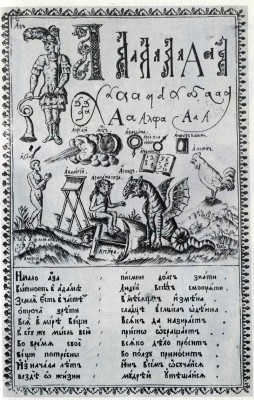Karion Istomin
Like Sylvester Medvedev, Karion Istomin (Zaulonsky) (mid-seventeenth century-after 1717) was born in Kursk.69 He came to Moscow not later than 1679, having already taken monastic vows. Here he worked as a redactor at the Printing House. The turbulent events of 1689 had little effect on Karion Istomin’s career, but the last decade of the seventeenth century was the time of his greatest success. He became firmly established under Patriarch Adrian and on 4 March 1698 was given the important appointment of head of the Printing House.
Karion Istomin is a very prolific and little studied poet. He is known for his pedagogical writings (the engraved ABC of 1694 and the type-set ABC of 1696). In fact he wrote panegyrics (beginning with a book presented to Sophia in 1681), verses for “coats-of- arms”, epitaphs, epistles to friends and even tried his hand at the genre of the heroic poem, in thirteen-syllable verse describing the second Crimean campaign of Prince Vasily Golitsyn (1689). Istomin was particularly successful at meditative lyrical poetry, reflections on the vanity of earthly life, the human soul, and death:
Воззрю на небо—ум не постигает,
како в не пойду, а бог призывает.
На землю смотрю — мысль притупляется,
всяк человек в ту смертью валяется.
По широте ли ум где понесется —
конца и края нигде доберется,
Тварь бо вся в бозе мудре содержится,
да всяка душа тому удивится.
Что небо держит, кто землю строит,
человеку како благу жизнь усвоит?
I gaze up at the heavens and know not:/How to get there, yet God calls./1 look at the earth and my wits are dulled,/For every man is cast down there by death./If my mind should fly around the wide world,/Nowhere will it reach the end/All creatures are kept by God in His wisdom,/And all souls do marvel at this:/What keeps the heavens, who makes the earth,/And how is a man to master a life of piety?
Apostille documents. Work with over 100 foreign consulates. History of Russian Literature
History of Russian Literature

